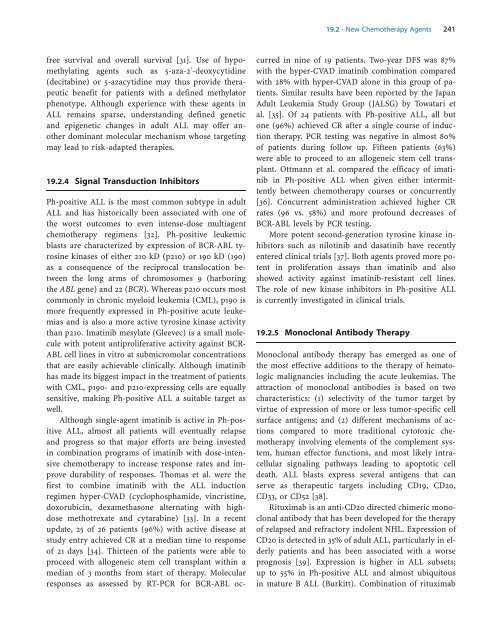Acute Leukemias - Republican Scientific Medical Library
Acute Leukemias - Republican Scientific Medical Library
Acute Leukemias - Republican Scientific Medical Library
Create successful ePaper yourself
Turn your PDF publications into a flip-book with our unique Google optimized e-Paper software.
a 19.2 · New Chemotherapy Agents 241<br />
free survival and overall survival [31]. Use of hypomethylating<br />
agents such as 5-aza-2'-deoxycytidine<br />
(decitabine) or 5-azacytidine may thus provide therapeutic<br />
benefit for patients with a defined methylator<br />
phenotype. Although experience with these agents in<br />
ALL remains sparse, understanding defined genetic<br />
and epigenetic changes in adult ALL may offer another<br />
dominant molecular mechanism whose targeting<br />
may lead to risk-adapted therapies.<br />
19.2.4 Signal Transduction Inhibitors<br />
Ph-positive ALL is the most common subtype in adult<br />
ALL and has historically been associated with one of<br />
the worst outcomes to even intense-dose multiagent<br />
chemotherapy regimens [32]. Ph-positive leukemic<br />
blasts are characterized by expression of BCR-ABL tyrosine<br />
kinases of either 210 kD (p210) or 190 kD (190)<br />
as a consequence of the reciprocal translocation between<br />
the long arms of chromosomes 9 (harboring<br />
the ABL gene) and 22 (BCR). Whereas p210 occurs most<br />
commonly in chronic myeloid leukemia (CML), p190 is<br />
more frequently expressed in Ph-positive acute leukemias<br />
and is also a more active tyrosine kinase activity<br />
than p210. Imatinib mesylate (Gleevec) is a small molecule<br />
with potent antiproliferative activity against BCR-<br />
ABL cell lines in vitro at submicromolar concentrations<br />
that are easily achievable clinically. Although imatinib<br />
has made its biggest impact in the treatment of patients<br />
with CML, p190- and p210-expressing cells are equally<br />
sensitive, making Ph-positive ALL a suitable target as<br />
well.<br />
Although single-agent imatinib is active in Ph-positive<br />
ALL, almost all patients will eventually relapse<br />
and progress so that major efforts are being invested<br />
in combination programs of imatinib with dose-intensive<br />
chemotherapy to increase response rates and improve<br />
durability of responses. Thomas et al. were the<br />
first to combine imatinib with the ALL induction<br />
regimen hyper-CVAD (cyclophosphamide, vincristine,<br />
doxorubicin, dexamethasone alternating with highdose<br />
methotrexate and cytarabine) [33]. In a recent<br />
update, 25 of 26 patients (96%) with active disease at<br />
study entry achieved CR at a median time to response<br />
of 21 days [34]. Thirteen of the patients were able to<br />
proceed with allogeneic stem cell transplant within a<br />
median of 3 months from start of therapy. Molecular<br />
responses as assessed by RT-PCR for BCR-ABL oc-<br />
curred in nine of 19 patients. Two-year DFS was 87%<br />
with the hyper-CVAD imatinib combination compared<br />
with 28% with hyper-CVAD alone in this group of patients.<br />
Similar results have been reported by the Japan<br />
Adult Leukemia Study Group (JALSG) by Towatari et<br />
al. [35]. Of 24 patients with Ph-positive ALL, all but<br />
one (96%) achieved CR after a single course of induction<br />
therapy. PCR testing was negative in almost 80%<br />
of patients during follow up. Fifteen patients (63%)<br />
were able to proceed to an allogeneic stem cell transplant.<br />
Ottmann et al. compared the efficacy of imatinib<br />
in Ph-positive ALL when given either intermittently<br />
between chemotherapy courses or concurrently<br />
[36]. Concurrent administration achieved higher CR<br />
rates (96 vs. 58%) and more profound decreases of<br />
BCR-ABL levels by PCR testing.<br />
More potent second-generation tyrosine kinase inhibitors<br />
such as nilotinib and dasatinib have recently<br />
entered clinical trials [37]. Both agents proved more potent<br />
in proliferation assays than imatinib and also<br />
showed activity against imatinib-resistant cell lines.<br />
The role of new kinase inhibitors in Ph-positive ALL<br />
is currently investigated in clinical trials.<br />
19.2.5 Monoclonal Antibody Therapy<br />
Monoclonal antibody therapy has emerged as one of<br />
the most effective additions to the therapy of hematologic<br />
malignancies including the acute leukemias. The<br />
attraction of monoclonal antibodies is based on two<br />
characteristics: (1) selectivity of the tumor target by<br />
virtue of expression of more or less tumor-specific cell<br />
surface antigens; and (2) different mechanisms of actions<br />
compared to more traditional cytotoxic chemotherapy<br />
involving elements of the complement system,<br />
human effector functions, and most likely intracellular<br />
signaling pathways leading to apoptotic cell<br />
death. ALL blasts express several antigens that can<br />
serve as therapeutic targets including CD19, CD20,<br />
CD33, or CD52 [38].<br />
Rituximab is an anti-CD20 directed chimeric monoclonal<br />
antibody that has been developed for the therapy<br />
of relapsed and refractory indolent NHL. Expression of<br />
CD20 is detected in 35% of adult ALL, particularly in elderly<br />
patients and has been associated with a worse<br />
prognosis [39]. Expression is higher in ALL subsets;<br />
up to 55% in Ph-positive ALL and almost ubiquitous<br />
in mature B ALL (Burkitt). Combination of rituximab
















